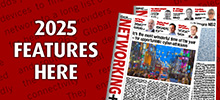04 November 2023

Data centre design and management faces increased pressure amidst the growing demand for environmentally responsible infrastructure. We asked the experts their views on the sustainable DC of the future
Which elements are key to building and maintaining a sustainable data centre (DC)?
Callum White, sales director, Critical Power Supplies: It’s estimated that DCs are responsible for as much as 3% of global electricity consumption. The amount of data created and stored will continue to grow exponentially over time, so DCs must become more sustainable.
As such, the industry must focus on energy efficiency and renewable energy integration. This means enhancing power monitoring and measurement capability to help understand consumption, creating a baseline for future savings, and identifying potential renewable energy source alternatives.
As DCs are so energy intensive, they also create a lot of heat, much of which can be captured to power infrastructure and other areas of a facility.
Andreas Sila, vice president data center and fixed access network, HUBER+SUHNER: The heart of any DC comprises essential components such as routers, switches, firewalls, storage systems, and servers, all dedicated to its core function. The journey to establish a sustainable DC necessitates a concerted commitment towards efficiency and mindful material choices. This extends to energy and water efficiency, waste minimization, construction materials, and even the strategic selection of the DC’s location.
It is imperative to comprehensively assess and address all sustainability aspects when embarking on the construction of a new DC. This means carefully looking at important factors to ensure the facility aligns with environmentally responsible practices and contributes positively to our collective efforts to combat climate change.
Dave King, senior product manager, Cadence: There are two crucial elements to building and maintaining a sustainable DC: experimentation to optimize performance and energy efficiency in the design stage; and ongoing operational analysis.
Deploying a digital twin allows facility managers to analyze DC design before they implement changes on-site. This can help visualize the most sustainable layout to minimize energy consumption and waste as well as conduct ongoing monitoring to identify what changes can be made to enable the most sustainable outcomes from existing facilities and resources. The ongoing use of digital twin technology, using physics-based simulation, helps maintain efficiency when the DC becomes operational. Customized reports and dashboards allow visibility of important metrics to make informed decisions.
Slawomir Dziedziula, director MultiLOB and IRS application engineers EMEA, Vertiv: Using alternative energy sources like solar or wind power can help reduce carbon emissions. Implementing Battery Energy Storage Systems (BESS) can help store renewable energy for backup and continuous power delivery. Moreover, the latest UPS systems can enable dynamic grid support features to help balance time on the grid and implement peak shaving.
Meanwhile, designing and maintaining the facility to achieve the lowest Power Usage Effectiveness (PUE) can be achieved with efficient cooling units, including free cooling and efficient air delivery e.g. use of containments and/or multi-speed fans.
Thermal management control logics allow the automated operation of the cooling units and help reduce waste through the adjustment of fan speed, multi-stage compressors and air supply temperature.
Applying for sustainability DC certifications to demonstrate that services have been audited and assessed by a credible third party such as Building Research Establishment’s Environmental Assessment Method (BREEAM), Leadership in Energy and Environmental Design (LEED) and ISO 50001 for Energy Management gives customers confidence that DCs are meeting ecological standards in terms of both build and maintenance.
Moreover, scheduling regular DC assessments to help manage continuous improvement and optimisation, and providing training to enable local staff to develop skills to design, operate and improve the efficiency of DCs.
How important is location to sustainability?
Callum White: Location plays a crucial role in DC sustainability as it determines access to renewable energy sources, climate suitability for efficient cooling, and proximity to power sources to reduce transmission losses.
Slawomir Dziedziula: The physical location of a DC can affect its energy efficiency and environmental impact. Locations with reliable access to alternative energy sources like wind and solar power, or less chance of extreme weather events, tend to have more reliable power supplies and can help reduce energy wasted by backup systems. If a DC is required in a less than perfect location, other steps can be taken to help it to be more efficient and environmentally friendly such as efficient cooling technologies, reuse of waste heat and implementation of circular economy strategies.
Dave King: In locations with more moderate climates like the UK, the challenge is to ensure cooling systems can operate efficiently across the whole range of temperatures throughout the year, whilst still accommodating the peaks. DC managers can deploy digital twins – virtual replicas of physical DCs – that use computational fluid dynamics (CFD) to simulate which cooling layouts are the most environmentally sustainable by conserving the most energy. For example, KAO Data in the UK was able to configure its cooling systems to prioritize efficiency, conserving energy resources, using CFD simulation.
Andreas Sila: Location is a crucial factor in DC sustainability for several reasons, including access to renewable energy, the local climate, energy grid carbon intensity, and proximity to users. The power for cooling the infrastructure is one of the main cost drivers. Those located in areas with abundant and accessible renewable energy resources have a significant advantage in achieving sustainability goals. Access to clean energy can greatly reduce the carbon footprint of DC operations.
On top of this, transportation can have a huge impact. The transportation of equipment and supplies to and from the DC, as well as employees’ commuting, can also have an environmental impact. Choosing a location with access to efficient transportation systems can reduce the environmental impact of the DC, while DCs located closer to the end-users can reduce the energy required for data transmission, as shorter network distances result in lower energy consumption. This is a consideration for edge DCs, which aim to bring computing resources closer to their point of use.
Is it possible to create a truly net zero DC?
Slawomir Dziedziula: Yes! DCs that can produce as much energy from sustainable sources as they consume can be considered as net-zero because their operations result in a zero-carbon footprint.
However, the manufacturing and disposal of DC equipment is an important aspect that involves the entire supply chain and includes scope 3 emissions, where more efforts are needed to reduce the carbon footprint. But what shouldn’t be underestimated is the changes DCs are making to improve - like other organisations, DC operators are on a journey to net zero - a journey on which they are fully committed and that will ultimately lead to environmental improvements.
Callum White: With advancements in technology and renewable energy integration, it is indeed possible to create a truly net zero DC that operates on 100% renewable energy and offsets its remaining emissions. The technology and solutions exist. The good news is that pressure is intensifying on DCs to become carbon neutral as part of Scope 3 emissions, there’s a growing commercial need to make it happen.
Andreas Sila: Creating a truly net zero DC is a challenging goal, but it is theoretically possible with the right combination of strategies and technologies. Achieving net zero status for a DC would require a comprehensive and holistic approach that addresses both energy consumption and carbon emissions throughout the DC’s lifecycle.
A great example of DC operators aiming for net-zero can be seen near HUBER+SUHNER’s Switzerland headquarters. This DC is Tier IV certified and uses solar panels on its roof and walls. What’s even more impressive is that it recycles its waste heat to heat a nearby cheese dairy.
Dave King: Reaching net zero isn’t currently a feasible reality for DCs due to compute-heavy demands and the growth in data-driven businesses. However, ongoing initiatives and a commitment to sustainable practices are steadily minimizing DC impacts. For example, the introduction of the EU Corporate Sustainability Reporting Directive – which will require roughly 50,000 large companies and SMEs across Europe to share the environmental impacts their organizations have – shows a massive step in the right direction. As does energy efficiency optimization with low PUEs.
What can we expect from the DCs of tomorrow?
Andreas Sila: The DCs of tomorrow are poised to be at the forefront of sustainable technology and practices, aligning with both environmental stewardship and economic viability. Commitment to energy efficiency, environmental friendliness, and integration into a broader sustainable ecosystem will not only help reduce carbon footprints but also lead to cost savings in the long run. As energy costs continue to rise and environmental concerns gain prominence, sustainable DCs will be well-positioned to meet the challenges of the future while setting a positive example for the broader technology industry.
Slawomir Dziedziula: All DCs will strive for improvements and set clear goals, including timelines, that will enable their facilities to meet government requirements and follow best practices to be more environmentally friendly. The DCs of tomorrow are expected to be powered by 100% renewable energy and meet high standards for energy efficiency. They are also expected to utilise any waste heat they will produce to benefit local communities e.g. district heating systems and vertical farms.
Callum White: Governments and commercial enterprises cannot meet their net zero commitments without the decarbonisation of DCs. It’s a dual challenge. On the one hand, tomorrow’s DCs need to be modular and scalable to accommodate the rapid growth of digital information. On the other, the most sustainable DCs in the future will need to prioritise several crucial elements, including renewable energy integration, energy-efficient designs, waste heat recovery, water conservation, circular economy practices, carbon offsetting, and transparency in reporting environmental metrics.
Dave King: The most sustainable DCs of tomorrow will offer a comprehensive approach to environmental responsibility where this is prioritized over pure capacity. Digital twin technology will be a key tool in their arsenal for achieving this as they can be leveraged for efficient design and optimization.
Other things DC managers will be doing include prioritizing renewable energy sources, maintaining low PUEs, and limiting water usage. Future-proofed DCs will also have rigorous recycling practices as they continually work to minimize their environmental impact.








